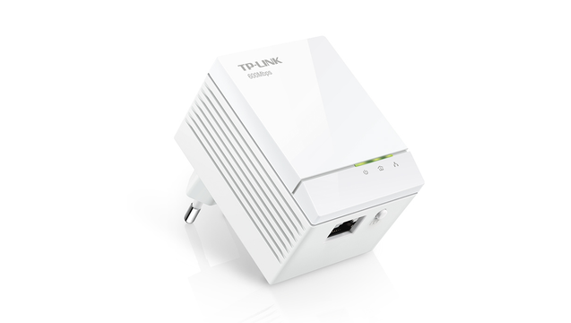

User GuideAV1000 Gigabit Powerline Adapter
About This Guide
This guide is a complement to the Quick Installation Guide. The Quick Installation Guide provides instructions for quick internet setup, while this guide contains details of each function and demonstrates how to configure them in typical scenarios. When using this guide, please notice that features of the powerline adapter may vary slightly depending on the model and software version you have. The powerline adapter availability may also vary by region or ISP. All images, steps, and descriptions in this guide are only examples and may not reflect your actual powerline adapter experience.*Compatible with all HomePlug AV and AV2 Standard Powerline adapters. This product may not be compatible with routers or gateways with firmware that has been altered, is based on open source programs, or are non-standard or outdated.*Maximum wireless signal rates are the physical rates derived from IEEE Standard 802.11 specifications. Actual wireless data throughput and wireless coverage are not guaranteed and will vary as a result of network conditions, client limitations, and environmental factors, including building materials, obstacles, volume and density of traffic, and client location.*Maximum Powerline signal rates are the physical rates derived from HomeplugAV/AV2 specifications. Actual Powerline data throughput and Powerline range are not guaranteed and will vary as a result of network conditions and environmental factors, including electrical interference, volume of traffic and network overhead, AFCI circuit breaker, and Powerline being located in a separate circuit.ConventionsIn this guide, the following conventions are used:
|
Convention |
Description |
| Teal Underlined | Hyperlinks are in teal and underlined. You can click to redirect to a website or a specific section. |
| Teal | Key information appears in teal, including management page text such as menus, items, buttons and so on. |
| Ignoring this type of note might result in a malfunction or damage to the device. | |
| Indicates important information that helps you make better use of your device. |
More Info• The latest software, management app and utility are available from the Download Center at https://www.tp-link.com/support/.• The Quick Installation Guide (QIG) can be found where you find this guide or inside the product package.• Specifications can be found on the product page at https://www.tp-link.com.• A community is provided for you to discuss our products at https://community.tp-link.com/.• Our Technical Support contact information can be found at the Contact Technical Support page at https://www.tp-link.com/support/.
Get to Know Your Powerline Adapter
This chapter introduces what the powerline adapter can do and describes its appearance.It contains the following sections:• Product Overview• Product Appearance
Product Overview
TP-Link powerline adapter aims to extend your exsiting home network, with the help of your home’s electrical circuit.
Product Appearance
Your powerline adapter may differ in appearance slightly from that depicted because of the region and product version.
LED Indicators
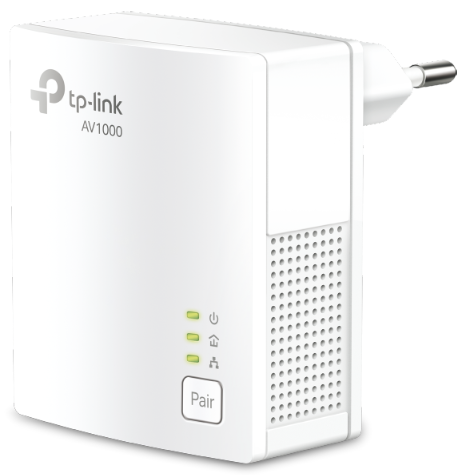

LEDs indicate the powerline adapter’s working status. For more details, please refer to the following table.
|
Name |
Status |
Indication |
| On/Off | The powerline adapter is on or off. | |
| Blinking | Quickly: Pairing is in process.Slowly: Power-Saving Mode* is on. | |
| On | The powerline adapter is successfully connected to a powerline network. | |
| Off | The powerline adapter is not connected to any powerline network. | |
| On | The Ethernet port is connected. | |
| Off | The Ethernet port is not connected. |
* Five minutes after the device connected to the powerline adapter is turned off or inactive, the powerline adapter will automatically switch to Power-Saving Mode.
Physical Interface
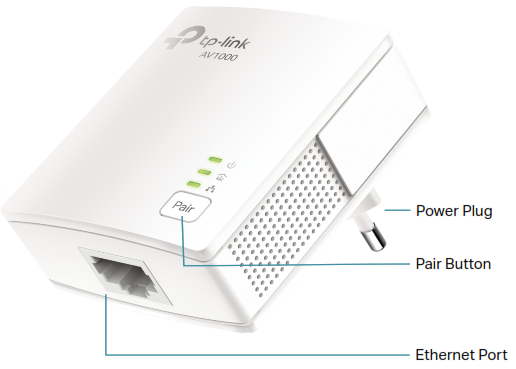

![]()
![]()
![]()
![]()
![]()
Use Your Powerline Adapter
This chapter guides you on how to use the powerline adapter.It contains the following sections:• Before You Start• Extend Your Wired Network by Plug & Play• Secure Your Powerline Network by Pairing• Add Another Powerline Adapter• Manage Your Powerline Network via tpPLC Utility
Before You Start
Powerline adapters work in pairs. You should have at least two powerline products to build a powerline network. To optimize your network performance, please follow these principles:• All powerline adapters should be on the same electrical wiring system.• Avoid plugging in powerline adapters and high-powered household devices (such as washing machines and refrigerators) close to one another.• Plug the powerline adapter directly into a wall outlet. Do not plug the powerline adapter into a power strip, extension cord, or surge protector.
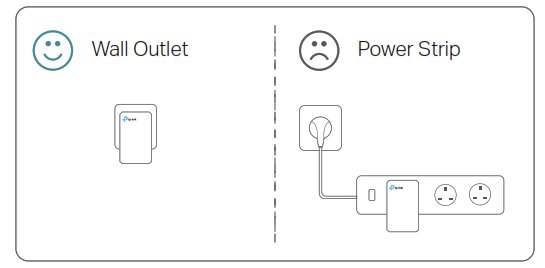

• Environment:Operating Temperature: 0 ºC ~ 40 ºC (32°F ~ 104°F )Storage Temperature: -20°C~70°C (-4°F~158°F)Operating Humidity: 10%~90%RH, Non-condensingStorage Humidity: 5%~90%RH, Non-condensing
Extend Your Wired Network by Plug & Play
I want to:Use two powerline adapters to set up a new powerline network in my house.For example, I have a router in my house, but there are not enough LAN ports for all my wired devices. I don’t want complex and expensive cabling. People told me that I can solve this problem with two powerline adapters.How can I do that?1 Connect one of the powerline adapters to an available LAN port of the router using an Ethernet cable.2 Plug the powerline adapter into a wall outlet.3 Plug the other powerline adapter into a wall outlet on the same electrical circuit.Wait until the powerline LED![]()
![]()
![]()
![]()
![]()
![]()
![]()
![]()
![]()
![]()
![]()
![]()
![]()
![]()
![]()
![]()
![]()
![]()
![]()
![]()
![]()
![]()
![]()
![]()
![]()
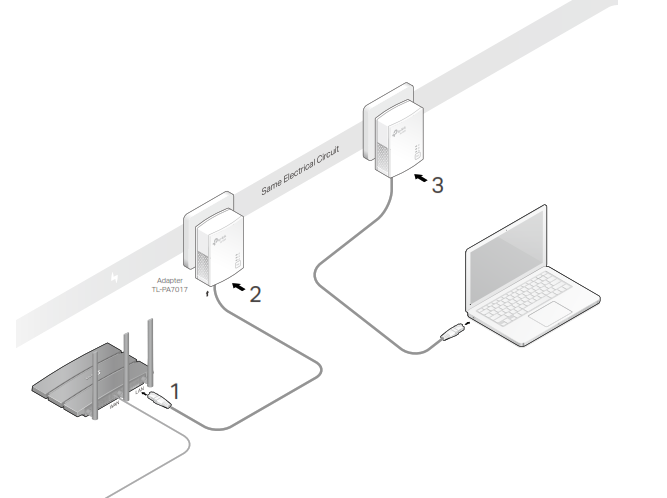

Done! Now enjoy the internet!
Secure Your Powerline Network by Pairing
All powerline adapters share some common factory settings and can communicate with one another. If you want your powerline adapters to communicate only with your own powerline adapters, you should pair them. Thus a secured powerline network is formed and other powerline adapters can no longer join your powerline network without being paired.![]()
![]()
![]()
![]()
![]()
I want to:Secure my powerline network and prevent other powerline devices from being added to my network.For example, I’ve extended my network using the Plug & Play method. Now I want to secure my network.
How can I do that?1 Verify all powerline devices’ Power LEDs![]()
![]()
![]()
![]()
![]()
![]()
![]()
![]()
![]()
![]()
![]()
![]()
![]()
![]()
![]()
![]()
![]()
![]()
![]()
![]()
![]()


Done! Enjoy your secure powerline network!
Add Another Powerline Adapter
I want to:Add a new powerline adapter into the existing powerline network to extend my network.For example, I’ve already set up a powerline network using powerline devices, but the network does not reach everywhere I need it to. I purchased another one to further extend my network.How can I do that?1 Plug the new powerline adapter into a wall outlet near one of the existing powerline devices.
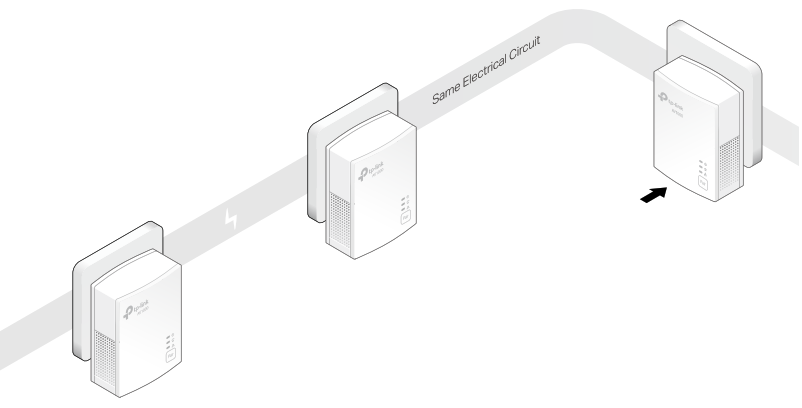

2 Wait for a minute and check whether the Powerline LED![]()
![]()
![]()
![]()
![]()
![]()
![]()
![]()
![]()
![]()
![]()
![]()
![]()
![]()
![]()
![]()
![]()
![]()
![]()
![]()
![]()
![]()
![]()
![]()
![]()
![]()
![]()
![]()


3 Relocate the new powerline adapter to the place where wired internet access is needed.
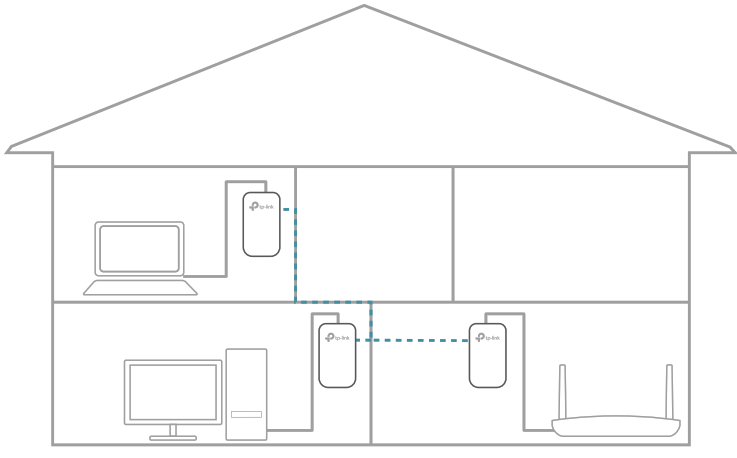

Done! Enjoy the internet through your extended network!
Manage Your Powerline Network via tpPLC Utility
The tpPLC utility enables you to view and manage your TP-Link powerline network. Its bold and intuitive interface helps you easily configure each powerline device.You can find the utility and its user guide on the product support page at https://www.tp-link.com.
FAQ (Frequently Asked Questions)
Q1 How do I reset my powerline adapter?With the powerline adapter plugged into the wall socket, press and hold its Pair button for more than 6 seconds until the Power LED![]()
![]()
![]()
![]()
![]()
![]()
![]()
![]()
![]()
![]()
![]()
![]()
![]()
![]()
![]()
![]()
![]()
![]()
![]()
![]()
![]()
![]()
![]()
![]()
![]()
![]()
![]()
![]()
![]()
![]()
![]()
![]()
COPYRIGHT & TRADEMARKSSpecifications are subject to change without notice.TP-Link is a registered trademark of TP-Link Technologies Co., Ltd. Other brands and product names are trademarks or registered trademarks of their respective holders.No part of the specifications may be reproduced in any form or by any means or used to make any derivative such as translation, transformation, or adaptation without permission from TP-Link Technologies Co., Ltd. Copyright © 2019 TP-Link Technologies Co., Ltd. All rights reserved.
FCC compliance information statement![]()
![]()
CE Mark Warning![]()
![]()
This is a class B product. In a domestic environment, this product may cause radio interference, in which case the user may be required to take adequate measures.EU Declaration of ConformityTP-Link hereby declares that the device is in compliance with the essential requirements and other relevant provisions of directives 2014/30/EU, 2014/35/EU, 2009/125/EC, 2011/65/EU, and (EU)2015/863.The original EU declaration of conformity may be found at https://www.tp-link.com/en/ceCanadian Compliance StatementThis device contains license-exempt transmitter(s)/receiver(s) that comply with Innovation, Science, and Economic Development Canada’s license-exempt RSS(s). Operation is subject to the following two conditions:1 ) This device may not cause interference2 ) This device must accept any interference, including interference that may cause undesired operation of the device.Industry Canada StatementCAN ICES-3 (B)/NMB-3(B)CAN ICES-6/NMB-6Korea Warning Statements
Safety Information• Keep the device away from water, fire, humidity, or hot environments.• Do not attempt to disassemble, repair, or modify the device.• Do not use a damaged charger or USB cable to charge the device.• The socket-outlet shall be installed near the equipment and shall be easily accessible• For passthrough devices, plug the power strips into the integrated electrical sockets of the devices, but devices of the same or another type not be stacked in normal use.• Plug the powerline devices directly into the wall outlets but not the power strips.• Plug the powerline devices into the wall outlets with earthing connection.Please read and follow the above safety information when operating the device. We cannot guarantee that no accidents or damage will occur due to improper use of the device. Please use this product with care and operate at your own risk.
Explanation of the symbols on the product label
|
Symbol |
Explanation |
| Class II equipment | |
| AC voltage | |
| Indoor use only | |
| Protection earth | |
| Functional earth wiring terminals only | |
| RECYCLINGThis product bears the selective sorting symbol for Waste electrical and electronic equipment (WEEE). This means that this product must be handled pursuant to European directive 2012/19/EU in order to be recycled or dismantled to minimize its impact on the environment. User has the choice to give his product to a competent recycling organization or to the retailer when he buys a new electrical or electronic equipment. |
References
[xyz-ips snippet=”download-snippet”]

